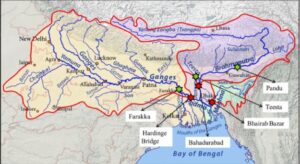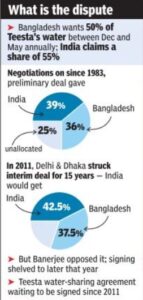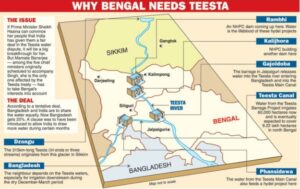Teesta water Agreement
Relevance
- GS 2: India and its Neighborhood- Relations.
- Tags: #TeestaWaterAgreement #IndiaBangladesh #TeestaRiver #UPSC #CurrentAffairs
Why in the News?
The Teesta River, originating in the Himalayas and coursing through Sikkim, West Bengal, and Bangladesh, has long been a point of contention between India and Bangladesh. Despite the significant strides made in their bilateral relationship, the unresolved water-sharing dispute has remained a persistent thorn in their ties.
Teesta River
- Origin: Teesta River( tributary of Brahmaputra) originates in the Himalayas, primarily from the Pahunri Glacier in Sikkim, India,
- Course: It meanders through Sikkimbefore entering the Indian state of West Bengal and ultimately flowing into Bangladesh, covering a distance of approximately 309 kilometers.
Tributaries of the Teesta River
- Rangeet River:One of its major tributaries, originating in the Himalayas.
- Rangpo River:Another significant tributary, originating in Sikkim.
- Lachung River:Contributes to the Teesta’s flow in the Indian state of Sikkim.
Importance to India
- Crucial for agriculture and hydropowerin Sikkim and West Bengal.
- Supports irrigation and sustains livelihoods.
- Key for water resource management and flood control.
Importance to Bangladesh
- Ensures water availability during the dry season.
- Vital for agriculture in northern Bangladesh.
- Supports livelihoods and economic stability.
Historical Background of Teesta River Water Agreement
| Year | Event | Significance |
| 1947 | India and Pakistan gained independence from the British Empire, and the Teesta River was divided between the two new countries. | This partition created the first border dispute over the Teesta River. |
| 1950 | India and Pakistan sign the Farakka Barrage Agreement, which gives India the right to withdraw water from the Ganges River upstream of the Teesta River. | This agreement had a significant impact on water flows in the Teesta River, and Bangladesh raised concerns that it would reduce water availability in Bangladesh. |
| 1971 | Bangladesh gains independence from Pakistan. | This created a new border dispute between India and Bangladesh over the Teesta River. |
| 1972 | India and Bangladesh sign the Indo-Bangla Treaty of Friendship, establishing the Joint River Commission (JRC) to manage transboundary water resources. | This treaty laid the foundation for cooperation between India and Bangladesh on water issues, including the Teesta River. |
| 1983 | India and Bangladesh sign an ad-hoc agreement on sharing Teesta waters, valid until the end of 1985. | This agreement was the first attempt to formalize the sharing of Teesta waters between the two countries. |
| 1984 | The JRC revises the ad-hoc agreement, giving India a 42.5% share of Teesta waters and Bangladesh a 37.5% share. | This revised agreement took into account changes in water availability and the needs of both countries. |
| 1998 | Bangladesh begins construction of the Teesta Barrage irrigation project. | This project was designed to improve water security for Bangladesh’s farmers. However, India raised concerns that the project would reduce water flows downstream to India. |
| 2009 | India and Bangladesh begin negotiations on a New Teesta water-sharing agreement. | These negotiations were aimed at developing a more comprehensive and long-term agreement that would address the concerns of both countries. |
| 2011 | India and Bangladesh reach an interim agreement on sharing Teesta waters, giving India a 42.5% share and Bangladesh a 37.5% share. The agreement is valid for 15 years, but is not signed due to objections from the West Bengal state government in India. | This interim agreement was a significant breakthrough in the negotiations, but it was ultimately unsuccessful due to internal political opposition in India. |
| 2019 | India and Bangladesh hold talks on the Teesta water agreement, but are unable to reach an agreement. | These talks were aimed at reviving the negotiation process and resolving the objections of the West Bengal state government. However, the talks were unsuccessful and the Teesta water agreement remains unresolved. |
| 2023 | India and Bangladesh continue to negotiate a Teesta water agreement. | The negotiations are ongoing, and both countries have expressed their commitment to reaching an agreement. However, there are still a number of challenges to be overcome. |
Reasons for the Delay in Concluding the Teesta River Water Agreement
Political Opposition in West Bengal
- West Bengal, a crucial state in India, has been reluctant to agree to terms that would involve sharing the Teesta’s waters with Bangladesh.
- Political leaders, like Mamata Banerjee, have expressed reservations, making it difficult for the Indian government to move forward.
Water Scarcity in North Bengal
- West Bengal’s concerns about water scarcity in its northern regions, where the Teesta flows, have intensified opposition to the agreement.
- The state argues that there is not enough water in the Teesta to share.
Changing Hydrology
- The changing climate and glacier retreat in the Himalayan region, where the Teesta originates, have led to reduced water flow.
- This has complicated negotiations, as the available water resources are diminishing.
Complex Water Flow Management
- The Teesta River is heavily dammed, with several hydropower projects in the upstream region, particularly in Sikkim.
- These dams control water release, impacting downstream flow and making it challenging to ensure an equitable share for both countries.
Sensitivities in Bangladesh
- In Bangladesh, the Teesta is considered crucial for irrigation, especially in the Rangpur region.
- Any perceived inequity in water-sharing arrangements could have political repercussions in Bangladesh.
Historical Issues
- Historical disputes, such as the Farakka Barrage conflict, have created distrust between India and Bangladesh regarding water-sharing agreements.
- Past grievances still affect negotiations.
UNESCO World Heritage Sites
- The Sundarbans, shared by India and Bangladesh and fed by the Teesta, are designated as UNESCO World Heritage Sites.
- The fate of these mangroves is linked to Teesta water management.
State vs. Central Government Authority
- The Teesta River issue highlights the challenges of federalism in India.
- While the central government negotiates with Bangladesh, state governments like West Bengal play a significant role in agreeing to water-sharing terms.
Lack of Consensus on Percentages
- Determining a fair percentage of water to allocate to Bangladesh has been a contentious point.
- Both countries have different proposals, and finding common ground has been elusive.
Domestic Political Factors
- Domestic politics in both India and Bangladesh can influence the stance of leaders and governments.
- Leaders may be hesitant to make concessions that could be perceived as compromising national interests.
Complex Negotiation Process
- Negotiating water-sharing agreements involves technical, legal, and diplomatic complexities.
- Differences in approaches, interpretations, and legal frameworks have made it difficult to reach a consensus.
Economic Development Priorities
- Both India and Bangladesh prioritize economic development, which includes harnessing river resources for agriculture, industry, and energy production, leading to conflicting interests.
Way Forward
A Multifaceted Approach to the Teesta River Water Agreement
- Scientific Assessment: Conduct a joint scientific assessment of water availability, considering seasonal variations and climate change impacts, to determine a fair and equitable water-sharing formula.
- Political Consensus: Seek political consensus at both the central and state levels in India, involving key stakeholders, to address domestic concerns related to water sharing.
- Economic Diversification: Encourage farmers on both sides of the border to diversify crops, reducing water-intensive rice cultivation through incentives and modern farming practices.
- Sustainable Practices: Promote sustainable agricultural practices, including drip irrigation and efficient water management, to optimize water use.
- Hydropower Coordination: Coordinate hydropower generation with the water release schedule to ensure minimum disruption to river flow during the lean season.
- People-Centric Approach: Prioritize the well-being of ordinary citizens in both countries, ensuring their concerns are considered in the decision-making process.
Both India and Bangladesh must engage in sustained diplomatic efforts to reach a mutually acceptable agreement. Solving the Teesta water dispute requires joint efforts and political will from both sides. It’s an issue that impacts the lives of millions of people and demands an inclusive approach for the benefit of both the Nations, fostering cooperation, environmental sustainability, and shared prosperity.
Source: Indian Express, The Diplomat
Mains Question
Discuss the historical context and key issues surrounding the Teesta River Water Sharing Dispute between India and Bangladesh. What are the major challenges in reaching a mutually acceptable agreement, and what steps can be taken to address them?






